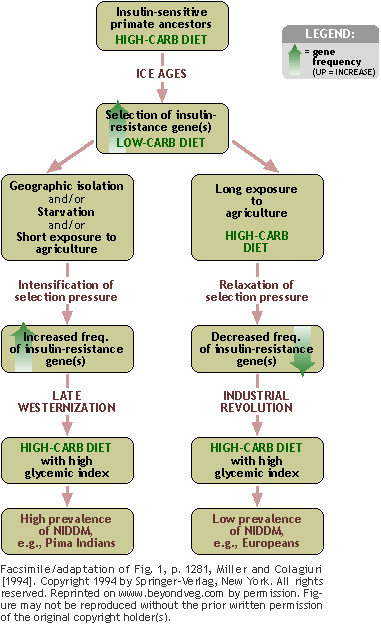![]()

|
|
 |
| Insulin Resistance: The Carnivore Connection Hypothesis of Miller and |
Our primate ancestors ate a high-Note here that insulin resistance is a disadvantage in the high-carbohydrate diet and the brain and reproductive tissues evolved a specific requirement for glucose as a source of fuel... [T]he Ice ages which dominated the last two million years of human evolution brought a low-
carbohydrate, high- protein diet. Certain metabolic adaptations were therefore necessary to accommodate the low glucose intake. Studies in both humans and experimental animals indicate the adaptive (phenotypic) response to low-
carbohydrate intake is insulin resistance... We propose that the low-
carbohydrate carnivorous diet would have disadvantaged reproduction in insulin- sensitive individuals and positively selected for individuals with insulin resistance. Natural selection would therefore result in a high proportion of people with genetically- determined insulin resistance.
The hypothesis is illustrated in the following figure.

| Courtesy link to Springer-Verlag's Springer Science Online graciously provided in exchange for permission to reproduce the above figure. |
![]()
Our hypothesis hinges on four lines of evidence.The beauty of the carnivore connection hypothesis of Miller and Colagiuri is that it provides an elegant, logical (and plausible) explanation for the increase in NIDDM that occurs when former hunter-
- that during the last two million years of evolution, humans were primarily carnivorous, i.e., flesh-
eating hunters consuming a low- carbohydrate, high- protein diet
- that a low-
carbohydrate, high- protein diet requires profound insulin resistance to maintain glucose homeostasis, particularly during reproduction
- that genetic differences in insulin resistance and predisposition to NIDDM can be explained by differences in exposure to carbohydrate during the past 10,000 years
- that changes in the quality of carbohydrate can explain the recent epidemic of NIDDM in susceptible populations.
![]()
Neel [1982] revisits the 1962 research, and notes that subsequent research invalidated several details of his 1962 paper. Neel's later paper provides three different approaches which might explain or support the original hypothesis of the "thrifty genotype" (as Neel's hypothesis is widely known). Two of the approaches revolve around having non-
The "not-so-thrifty genotype" hypothesis of Reaven [1998a]. Reaven [1998a] hypothesizes that the underlying function of insulin resistance is not to increase fat storage as Neel suggests, but to spare muscle tissue from proteolysis, i.e., to preserve muscle tissue in periods of famine. Reaven [1998a] claims (and provides one citation in support) that there is evidence that insulin-
Ozanne and Hales [1998] challenge Reaven [1998a], and note that the evidence is weak in support of claims that NIDDM has a genetic basis. They also note that Reaven's approach suggests that individuals with NIDDM are sensitive to the anti-
Both hypotheses (Neel, Reaven) are based on a dubious assumption. Cordain
GO TO NEXT PART OF ARTICLE
Return to beginning of article
Back to Research-Based Appraisals of Alternative Diet Lore
![]()
(Insulin Resistance: An Alternative Vegetarian Hypothesis Assessed)
SEE TABLE OF CONTENTS FOR:
PART 1 PART 2 PART 3 PART 4 PART 5 PART 6 PART 7 PART 8 PART 9
GO TO PART 1 - Brief Overview: What is the Relevance of Comparative Anatomical and Physiological "Proofs"?
![]()
GO TO PART 2 - Looking at Ape Diets: Myths, Realities, and Rationalizations
![]()
GO TO PART 3 - The Fossil-Record Evidence about
![]()
GO TO PART 4 - Intelligence, Evolution of the Human Brain,
![]()
GO TO PART 5 - Limitations on Comparative Dietary Proofs
![]()
GO TO PART 6 - What Comparative Anatomy Does and Doesn't Tell Us about
![]()
GO TO PART 7 - Insights about Human Nutrition & Digestion from Comparative Physiology
![]()
GO TO PART 8 - Further Issues in the Debate over Omnivorous vs. Vegetarian Diets
![]()
GO TO PART 9 - Conclusions: The End, or The Beginning of a New Approach to